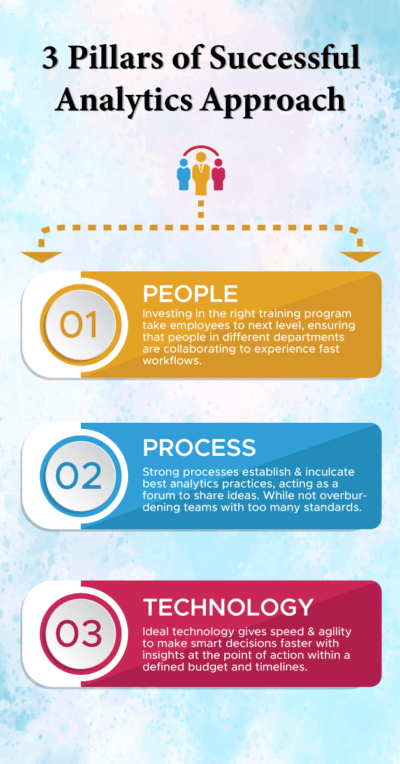
Sign up to receive latest insights & updates in technology, AI & data analytics, data science, & innovations from Polestar Analytics.
Today, organizations are dealing with enormous data volume, generated from external and internal resources. To succeed in today’s business climate, everyone from business managers and marketing directors to finance professionals and technology pros need a good analytics strategy to deliver insightful and actionable analytics on the captured data.
Organizations can no longer afford to base their decisions on gut feelings and hunchs. Data-backed insights must move the needle for organizations to stay competitive and that needs strategy and analytics. Moreover, this also requires clearly collecting, analyzing, and then applying the lessons learned from the company’s data.
Transforming into a data-driven enterprise through the implementation of an enterprise-wide data and analytics strategy can help organizations overcome the challenges of mismanaging analytics projects. With a Business Analytics strategy in place, organizations can make informed decisions based on internal and external information assets, leading to increased opportunities and success.
Identify the reason behind the failure of the Business Intelligence initiative for your enterprise.
A data-driven enterprise bases its routine decisions on actionable and timely insights from reliable data. Leveraging data to develop a strategy acts as the basis for all their strategies, driving efficiency into the whole process. Data-driven organizations are known to consistently outperform non-data-led organizations in making informed and effective decisions to drive profitability and cut down on costs. This has resulted in almost every organization today actively taking initiatives to become more data-driven. But few succeed.
According to a study by Gartner, nearly 70-80% of business intelligence initiatives fail. There are significant roadblocks that every organization faces. And overcoming this is often the difference between success and failure, and which needs to be addressed before organizations can achieve the data nirvana.
According to the New Vantage Partners Big Data Executive Survey 2018, when the management was asked about what was preventing their firm from becoming more data-driven, 48.5% of executives mentioned that the problem was related to the people in the firm, another 32% blamed the company processes while according to 19.1% technology was the reason for this shortcoming.
Learn more about how to implement an enterprise-wide BI implementation and which approach to take.
The analytics strategy should first evaluate the unique business challenges, map those challenges with the right solutions, and communicate actionable insights to help key decision-makers. Analytics demands costly investments in technology.
But before considering what would be the right technology, you must evaluate your needs, your current state, and your to-be state. This should decide your Data analytics strategy.
Define the milestones in your road map. Identify stakeholders. This step is very crucial and takes an expert’s help if required. Consider your expected data growth, your in-house capabilities, and existing technology gaps.
Here is a useful infographic that succinctly summarizes the points for you

Successful analytics adoption would require changing some existing core practices and individual habits. This might require you to strongly convince your employees to change the way they view and manage data, and frame and make decisions this is hard to do. So, how to drive this change? Understand the current user skill levels with analytics. Invest in the right training programs that will take them to the next level.
Motivate the employees by offering them valuable training programs that will enhance their careers. It would ensure that they put in the extra effort to learn the technology and apply it for organizational benefit. This would be a win-win situation for both companies and employees at the same time.
Sometimes the change would find resistance from people who doubt the extent of benefits that this technology will provide. You must take the stakeholders into confidence with your big data analytics strategy and the need for a shift in processes. Otherwise, they might end up not adopting this. Understand the concerns, if any, raised by all stakeholder groups and identify their current challenges and their expectations from the tool.
Show them the value and benefits. You would find that getting a top-level executive actively sponsoring the project helps greatly.
When the communication comes from the top, it will ensure that users mandatorily incorporate this into their active work-flows. It will ensure that it is taken as a priority across the organization and speed up the adoption. Have a team of technology experts and business experts to formulate the business analytics strategy for data management, analytics, and governance.
Ensure that people in different departments are collaborating and important information is not locked away in organization silos. Departments must be readily sharing information in order for your analytics efforts to get wings and fly.
You need a solid organizational framework in place that ensures fast data collection, processing, analysis and consumption of the right analytics dashboards and reports. A successful analytics project requires you to have strong processes in place to manage the change.
The process must define which data sets to collect, manage, and build governance around. A center of excellence can be set up in-house that establishes and inculcates best analytics practices. It can function as a forum for team members to share ideas and techniques.
There must be well-organized procedures for managing the conflicts and priorities, evaluating and developing required software, requirements gathering, cross-functional communications, deploying and designing models, handling job errors, and handling data, among other things.
However, do not overburden your teams with too many processes and standards. It will impede agility and flexibility With the right processes in place, you can increase adoption, reduce your risk, and achieve maximum business value.
Selecting the business intelligence or analytics tool that would be perfect as a part of your enterprise analytics strategy is critical to success. There’s no one-size-fits-all business intelligence analytics tool. The best business intelligence software is not necessarily the product with the most features. Rather, you should determine which tool best fits your actual requirements and which will enable the types of analysis your users need and will use.
You must evaluate the current application landscape and expectations from the solution. Technology should not limit you from the capability perspective. Today analytics tools come with advanced features such as self-service data preparation, self-service data model creation, and self-service visualization.
These features make it very easy for business users to work with data and develop complex analytics for unprecedented insights and collaboration. Your analytics technology should deliver timely data insights.
It must connect with the enterprise data sources and have the required ETL capabilities with the right data architecture and data management solutions. It should have the right data governance inbuilt into the tool. The ideal technology will give your users the speed and the agility to make decisions faster with insight at the point of action within a defined budget and timelines.
Having the right tools and technologies, modifying practices, and adapting the mentalities will guide your journey towards success. A lot of moving pieces must balance for the right solution to be deployed.
Inculcate a culture of analytics, have the right people on board, get your organization strategy on one page, and have the right architecture and data management strategies in place. Getting these components rights will maximize the value of enterprise data and deliver remarkable and trusted insights. Read about our expertise in implementing data analytics and contact us to have data analytics implementation tailor-made to your requirements.
About Author

Insights Explorer
If data is oil, then analytics is the combustion engine of this current era.